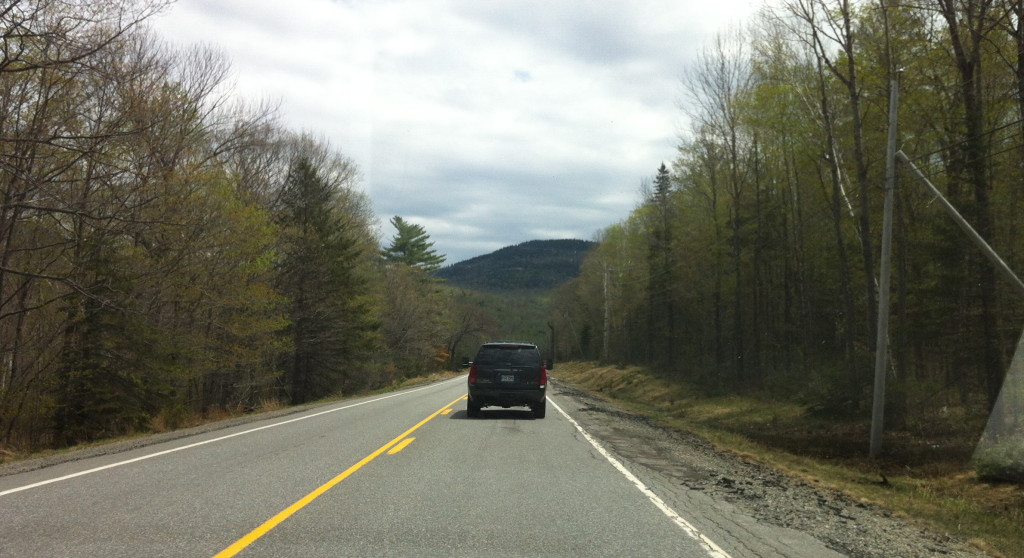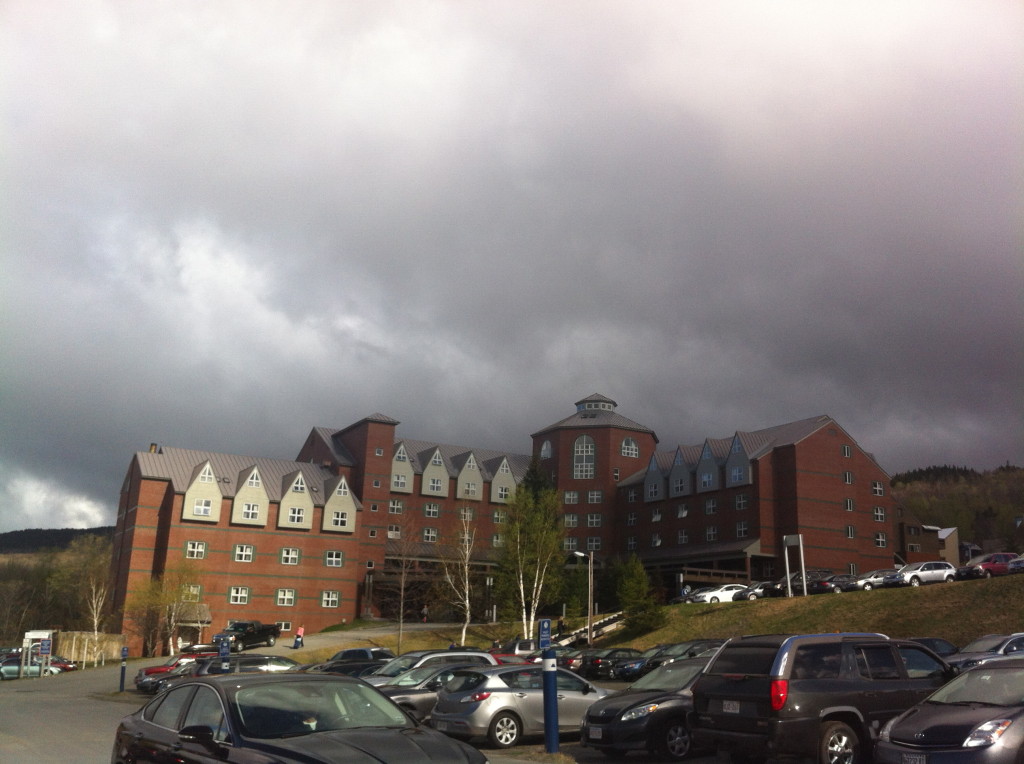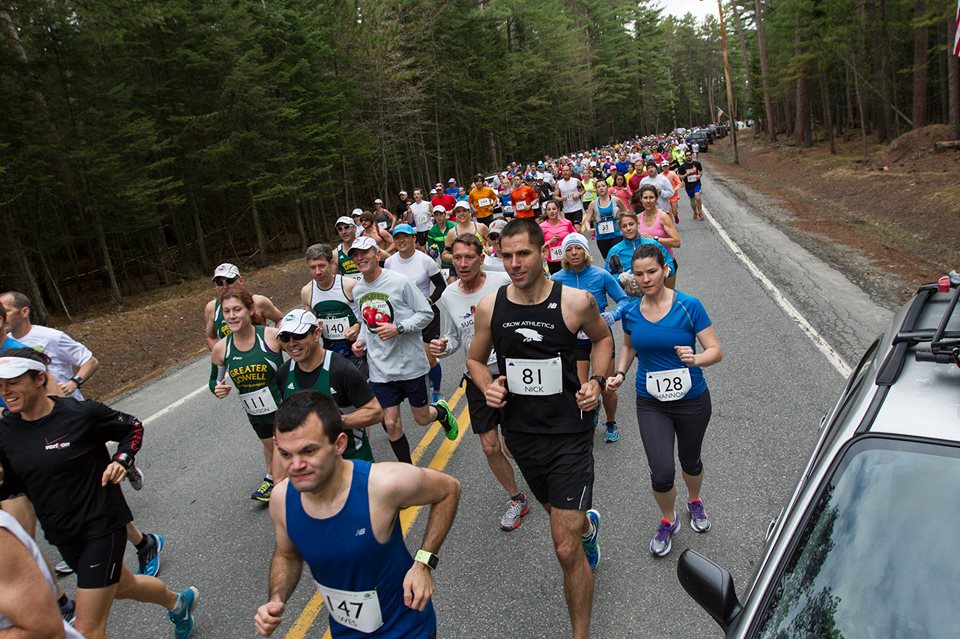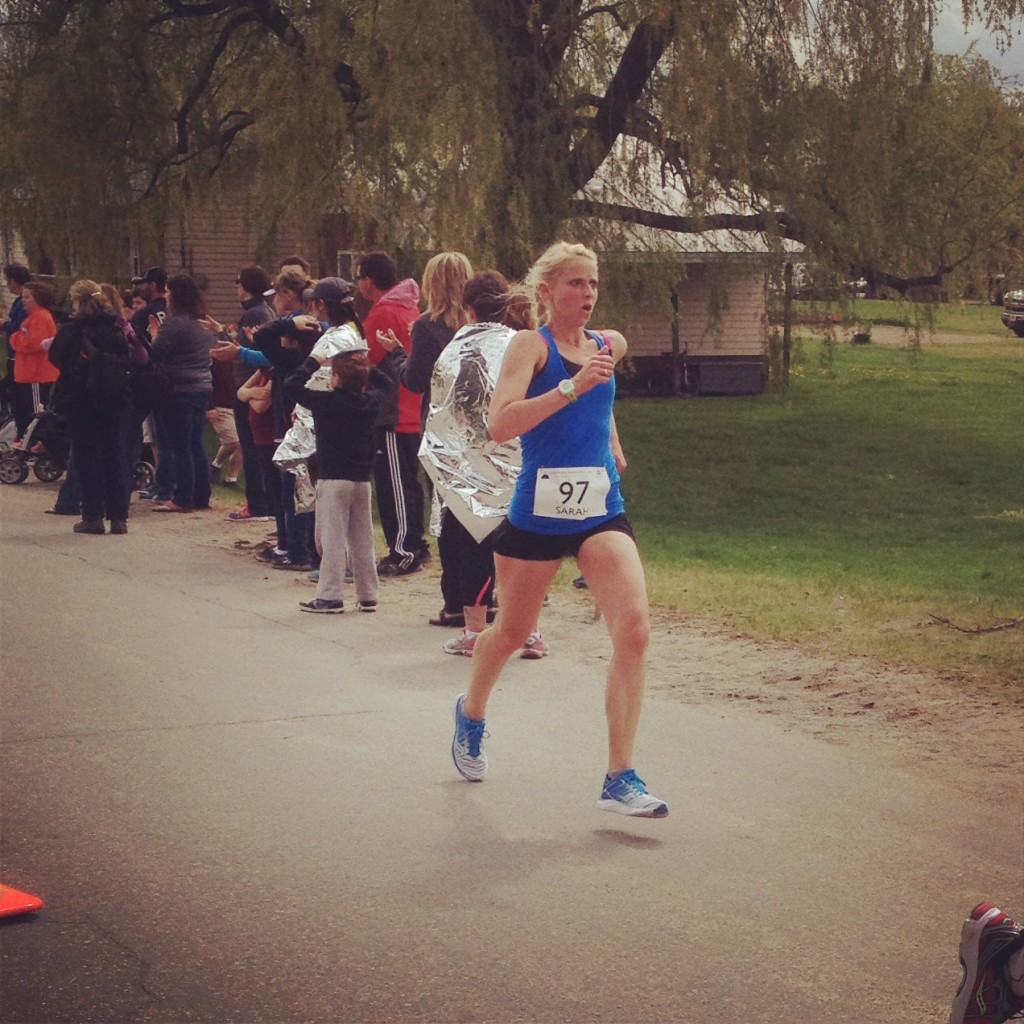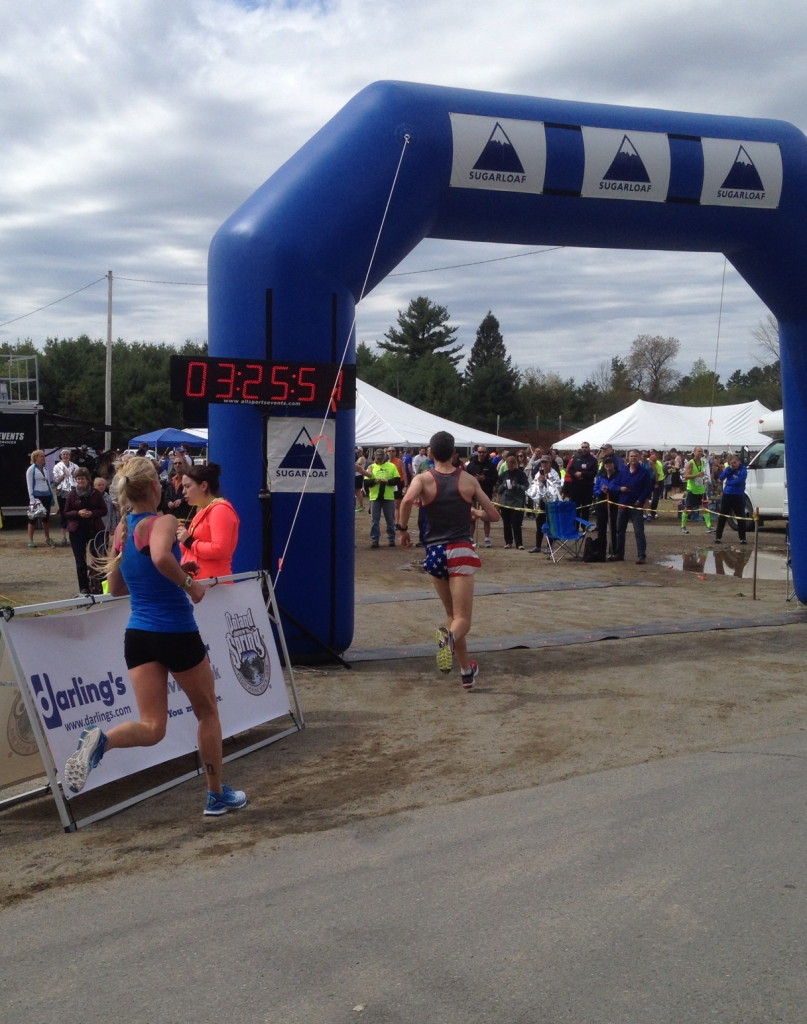Sugarloaf Marathon Recap
The only real way to start my recap of the Sugarloaf Marathon I ran on Sunday is to go back. Back to 2001. I was 18 and in a desperate struggle for my life and well being. I had recently been diagnosed with anorexia nervosa and when I wasn't in my freshman-year classes I was sitting in the office of a psychologist or nutritionist or physician trying to work through all of my "issues". It was the beginning of my recovery and I wanted desperately to get better. I can recall sitting at my desk in my itty-bitty dorm room on the sixth floor of the freshman tower at Syracuse thinking, "I want to be healthy enough to run a marathon." At the time I wasn't healthy at all: my skin was gray, my hair was falling out and I barely had the energy to walk to class. I equated the ability to run a marathon with strength and well being. If I could do that, then I'd be better. I know now that my logic was faulty. There was healing that needed to happen that simply running a marathon could not do; deeper emotional layers that needed to be peeled back and dealt with so that I could be completely free. In some ways running has helped me peel back those layers, it has taught me about myself and the strength that I have, but ultimately it couldn't give me the freedom I needed.
In 2003 I was healthy enough to running again (at least on the outside I'd gained weight...I was still struggling with bulimia and struggled until 2009) and made it my goal to train for a marathon. I wanted to run the Boston Marathon. I didn't know much about running, but it seemed like one of the better known races and it wasn't too far away. Then I found out you had to qualify in order to run. I opted to run the Portland Maine Marathon in October of 2003 as my qualifying race. I went into the race with full confidence that I'd run a 3:40, it was what I had trained for. I have no idea what my splits were that day, but I felt great until mile 23 when my foot blew-up with plantar fasciitis. The pain was intense and I ran/walked/hobbled the last three miles to finish in 3:51:48. I was on crutches for a week after the race.
My desire to qualify for Boston didn't lessen. In fact it increased. I felt like I'd come so close. Next time, I told myself. I ran two more marathons in 2007. At the time I was still struggling with bulima and was really in no shape to run a marathon. I finished in 4:03 and 4:11. I ran two more in 2011 (when I was no longer struggling with bulimia) with similarly disappointing times. Each time I ran trying to qualify for Boston, each time I finished disappointed, exhausted and wanting never to run another marathon. In fact the hardest and possibly most disappointing marathon was San Diego in 2007, I finished that race and didn't run again until 2010.
When I signed up for the Sugarloaf Marathon in January my one goal: finish feeling triumphant. I wanted a different marathon experience. I didn't want to run because I was trying to qualify for Boston, I wanted to run to have a good race. I wanted to cross the finish line wanting more, not ready to swear off running for the rest of my life. I knew that the only way I was going to get that "triumphant" feeling was with a serious change to the way I was training and to my mindset regarding the marathon. I needed to work harder than ever before and I needed to let go of the marathon being all about running a Boston Qualifying time. And this winter that's what I did. [I plan on designating an entire post later on to explaining my training this cycle.] On Sunday I knew I had training I could trust and that allowed me to focus on each moment and perform in the way I imagined. One step at at time, to cross the finish feeling triumphant.
The Course: If there ever was a race for me it is the Sugarloaf Marathon: small, rural and completely scenic. As I reflected on past marathons I realized most of them have taken me down city streets: Rock and Roll Arizona, Rock and Roll San Diego. Even the Maine Marathon and Vermont City Marathon take you through city streets and suburban neighborhoods. It was a four hour drive north of where we live in New Hampshire. We drove part of the course as we approached Sugarloaf: the road is a rural state route, lined with pine trees and dotted with the occasional tiny, A-frame ski chalet. The Carabasset river runs along the road; hills dotted with freshest greens of spring tower in the distance. These are the kinds of views that feed my soul. I knew even before I ran the course that this was the race for me.
The course itself could be described as "business in the front, party in the back"...if you run it the right way. There was a significant hill climb ~400ft in elevation gain from mile 8-10, which is preceded by a few rollers from 5-7. The party comes when you crest the hill at ten and descend a steep grade that levels out a bit but keeps on descending until you get to the finish in Kingfield, Maine. You lose a total of 980 feet in the last 16 miles of the race. But those last 16 aren't without a few rises that can slow you down a bit if you're feeling fatigued. It can be a really favorable course.
The course is a point to point and was open to traffic, which in my mind was great because it was a fool-proof spectator course. Drive, park, cheer. Drive past runner, cheer, honk. Drive, park, cheer. Repeat. I saw my husband every 3-4 miles which was amazing!
My Race Plan: On Friday I posted my race plan. They were really my mantras for the race itself, I didn't really want to hash out my race plan on the blog. My plan was the following: run conservatively for the first three miles and aim to come through the 5K around 24 minutes (8min/mi). Pick up the pace a bit for 3-7 and then run comfortably on the hills. Don't attack the hills, just strong and steady. And then drop the pace a bit more after cresting the hill at 10. Push a little if it felt good from 10-16. At mile 16, if I felt good run hard for the last 10 (similar to what I did at Eastern States). I wanted the last ten miles to get progressively faster and to hopefully finish with my pace in the low 7's or high 6's for the last few miles. I thought my race plan quite a bit last week, until Friday and then I stopped thinking about it. I didn't want to over think it, so Saturday I tried focus on other things. My overarching time goal was to run a sub 3:30. But I thought it was realistic to a sub 3:20 if everything went as planned and I could really push and see low 7's in the last 6 miles.
At this point I had chosen to wear my Garmin. Mostly I chose to wear the Garmin because it has a bigger display. I wanted to be able to see numbers at a glance: pace or time or distance. The numbers on my Timex Ironman can be small, especially the splits and if I miss that window of when they show up I cannot trust my math-on-the-run to be accurate. I decided the Garmin would be less potential energy expenditure. So I wore the Garmin on the Time/Distance setting and occasionally looked at the splits. I was actually surprised at how infrequently I looked at the splits: not really at all in the first 10 miles and then maybe every other mile in the last 16.
Race Morning: I woke up at 4:30am (race start was 7am) ate, quietly dressed and made my way down to the hotel lobby. The morning was perfect. Cool (45 degrees) and crisp, the weather could not have been better. I boarded the bus and we drove the first 11 miles of the course from Sugarloaf to Eustis, Maine where the race started.
We had an hour before race start and I held on to my clothes as long as I could before handing my bag over to the baggage-bus. It was a little chilly. Everything felt great, except for my tummy. I was in and out of the porto-potty 4-5 times. I'd feel fine and then not so fine. By the time we lined up for the race I was feeling fine. But then around mile two I was feeling not-so-fine.
The Race:
Miles 1-3: I seeded myself sort-of towards the front of the 500+ runners. I wanted to run the first miles slow, so getting sucked out with faster folks was not in my plan. I started easy and about a mile in heard someone call my name. An Instagram friend, Jasmine was running too (a huge congrats to Jasmine who ran 3:45 for a 30 minute PR!). We introduced ourselves and chatted for a little while. It was the perfect way to start the race, since I ran the rest of the way solo. I crossed the 3 mile mark at 24:xx. (8:20,8:18, 8:16)
Miles 3-5: I took these easy. I switched my Garmin to the Time/Distance setting. I'd used the pace setting to try to keep myself from going out to fast in the first three. And simply ran. I looked around, enjoyed the scenery and tried to convince my body that I didn't have to go to the bathroom. We hit the first few rollers and they felt easy. (7:56, 8:08, 7:53, 8:08)
Miles 6-10: The rolling hills got slightly bigger in mile six and the steady climb really started around mile 7.5. I felt smooth and strong and the hills didn't feel nearly as difficult as they had looked from the car the night before. I was still fighting that feeling in my stomach, but knew there was a porto-potty around mile nine at The Appalachian trail parking lot that I could use. I kept up that hill and saw my husband at the entrance to the parking lot. I waved, asked if the porto-potty was still there (why I asked that I don't know) he said "no" and the lady next to him was like "yeah...its right there." It seriously took me forever to decide if I was going to use it. The porto-potty was in the middle of this drive-in, drive-out parking lot. Do I run in this end? Will I get in trouble for going off the course? What if that takes longer? Do I go up the hill more and run in the other end? Then I'd be running back down? Wouldn't that be longer? Do I cut through this little bit of woods?Should I stop here or keep going? All of this went through my head in like 10 seconds and when I'd passed option one and was about to pass option two, I careened into this little patch of woods, leapt over the gully (almost twisting my ankle on a rock) and into the parking lot coming out right next to the porto potty. Seriously?! I thought and laughed to myself. Is this really happening?Did I just leap through the woods in the middle of a marathon? I got back onto the road as quickly as possible. My watch auto paused once I stopped careening and leaping, so all total I have no idea how much time I lost. Maybe a minute? Shortly after the porto-potty debacle I crested the hill, and felt like the first part of the race was over. It was time to get to work. (7:53, 8:01. 7:53, 8:17, 7:58)
Miles 11-14: I tried to take it easy on the steep downhill, knowing I'd need my quads in the last three or four miles. I didn't want to pound to hard now, only to come up limping at the end. I settled into a nice rhythm and then saw my husband again around the 13 mile mark. I checked my watch at the halfway and came through 13.1 at about 1:44. Which was right where I wanted to be. I knew I had a few more miles to go before I pushed into the next gear. And I was still feeling tummy trouble. I knew that if I wanted to run faster I had to deal with it, so at around mile 14 I ducked into the woods (did I mention I like rural races?) and came out feeling 100% better. I was more decisive about this "duck in" and I think maybe I added 45 seconds to my time. Who knows? (7:47, 7;39, 7:51, 7:48)
Miles 15-19: I got kind of excited in mile 15. I was feeling better, I was ready to push and anticipating mile 16 when I wanted to start executing my "progression run" into the finish. These miles were some of my fastest. I felt strong. I was in a great rhythm and my body was finally cooperating. The miles ticked by at a consistent rate. I felt the way I'd imagined feeling: strong, steady and confident. (7:22, 7:09, 7:26, 7:33, 7:32)
Miles 20-23: As I came past the Mile 20 marker I felt my first bit of doubt. Can I keep this up? I still have six miles to go. Can I maintain this pace? We faced a few little rises, probably 50 feet in elevation. Enough to exaggerate the fatigue that I was now starting to feel. My legs, especially my quads felt tired. My lungs felt great, my heart rate was low. In every other aspect I felt comfortable, but my legs were getting tired. Before the race an old song, a Psalm (Psalm 121) put to music that I used to sing at summer camp, came to mind: I will lift my eyes to the hills and their creator, who made all heaven and earth. For he watches me, will not sleep, no never slumber. He is ever over me. It was the hills that surround the course that brought it to mind. In those moments of doubt I lifted my eyes to the hills. It seemed so fitting. It brought my focus away from the doubt and all the negative thoughts about fatigue. I kept telling myself: You can only perform in the present. You can only run this moment. Run this mile. One at a time. One step at a time. If I thought about the outcome and the time I wanted to run, I'd remind myself to focus on the present. Perform in the present. Lift you eyes. Those were the mantras that got me through mile 20-23. They weren't my slowest miles but they weren't as fast as I had wanted to run. (7:50, 7:40, 7:56,7:43)
Miles 24-26. Once I passed the 23 mile marker I glanced at the time on my Garmin for the first time since the halfway point: 3:01. 3:01 I thought. I have a 5K left I can push these last three. I started to focus on my form: chin up, knees up, flick the ankles, core engaged. These little form cues helped. My pace quickened. My legs were tired but I wanted to run those last few miles fast. I saw my husband at mile 24, flashed a huge grin and two thumbs up and then told him to get to the finish line! Mile 24 bleeped by in 7:31. Ok. I thought two more miles an two more hills. A friend of mine had said there would be two little hills in the last two miles. I knew I'd have to attack them to keep my pace steady. There was one in mile 25, it came and went 7:24. And another little hill at the beginning of mile 26. I knew we finished in town and I kept waiting to see the first signs of the town. The last water stop was a mile out. C'mon. This is taking forever! I thought. Finally there it was: the town, the people. I don't remember passing the 26 mile marker (7:34). I glanced down at my watch with a half mile to go. Get it in the 6's I thought. My paced showed 6:50. Finish hard. Finish hard. And then there was a Subaru in my way. Well sort of. I kind of ran next to it, until some volunteer stopped the guy.
It made my final push into the finish chute a bit interesting. I ran the last .32 in 33 seconds (6:45 pace) to cross the finish line in 3:25:43 (official).
I crossed feeling triumphant. I finished fast. I finished strong. I'm eager to run again. I can't wait really. And....I qualified for the Boston Marathon, by ten minutes:) In a way the Sugarloaf Marathon was the culmination of a longtime dream, one that has morphed and changed as I have been able to deal with and heal from the issues that were at the root of my eating disorder. The marathon went from something I wanted to do to feel healthy, to something I wanted to do to conquer the distance. So many times I felt like the marathon chewed me up and spit me out. On Sunday I totally owned every inch of 26.2. I never felt chewed up or depleted. Even if I never run another marathon I feel like I'm at peace with the distance. I did what I came to do. I executed and that is a pretty good feeling.
Nutrition:
I'm pretty sure that my race day "tummy" issues came from the roasted beets and broccoli I ate on Friday night (although I ate that before Eastern States and was fine) and/or the high-fat pasta dinner I had the night before the race. I ordered a chicken pasta dish that was served with a "white sauce" (cream based) and probably should have opted for a "red sauce" (tomato based). I eat dairy, but not a lot. I just don't think it was that happy with the creamy, buttery, fatty sauce. It tasted good though. So it had that going for it.
Here's what I had race day:
4:30am Bagel and Peanut Butter
6:30 am Generation UCAN
Miles 6-7 VFuel Gel
Miles 13-14 V Fuel Gel
Mile 20 GU
Water was provided every two miles and I took water at almost every stop. I skipped one or two.
What I Wore:
Lululemon Cool Racer Back Tank
Athleta Presto Shorts (they have three pockets!)
Fun Numbers:
5-Times I saw my husband
3-times I waved and got all excited that someone knew my name before I remembered it was printed on my bib
6th- in age group
23-minutes I shaved off my marathon time from 2011
1-number of times I pretended to honk while running. kids on the course reminded me of my kids and it got a little fun:)
112- out of 507 runners
888.7-number of miles I logged in this training cycle
1-number of Subaru drivers I'm slightly annoyed with
19th- overall woman
1:38:57- a new half marathon PR, run in the second half of the race
--Sarah
I love connecting with readers! You can find me here:
Email: RunFarGirl [at] gmail [dot] com
Twitter:@Run_Far_Girl
Instagram: instagram.com/runfargirl
Facebook:Facebook.com/runfargirl262
Pinterest: pinterest.com/runfargirl
Daily Mile:dailymile.com/people/scanney
